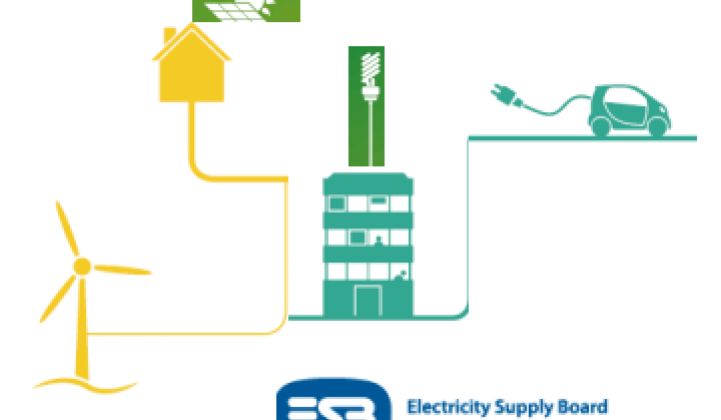In response to the challenge of climate change, most U.S. utilities quiver with uncertainty or greenwash aggressively while looking for new coal supplies. Not so with Ireland’s ESB.
"In 2008, in response to Europe’s CO2 reduction targets,” said John Campion, ESB’s Executive Director for Sustainability, “we put this stake in the ground that we are going to be net carbon neutral by 2035, with interim targets of 30% reduction by 2012 and a 50% reduction by 2020.”
Campion says 42 percent of Ireland’s renewable electricity will be generated by wind in 2020. “We will be by far the biggest wind generator in the world pro-rata.”
Ireland’s commercial, semi-state utility was founded in 1927, right after the birth of the Irish state. “It was a raw country with few resources and young people running it” who decided to harness the River Shannon to generate electricity, Campion said. “It was a really ambitious, groundbreaking, crazy project” and “a huge statement by the new country that it was up for it.”
Now ESB owns Ireland’s transmission system, owns and operates its distribution network and owns a diminishing proportion of Ireland’s 5,000-megawatt generation capacity. “Ten years ago, we had 100 percent of the supply business in the Republic of Ireland,” Campion said.
An EU Directive in 2000 calling for competitive electricity markets changed all of that. “We now have 45 percent,” Campion explained. “Bord Gais and Airtricity are taking customers from us -- like 6,000 or 7,000 a week.”
The impressive 2008 strategy, for which ESB has earmarked a 22-billion-euro investment, is part of the transition. “The first thing is to build a renewables business of scale,” said Campion. “That would be about 1,400 megawatts of wind and about 150 megawatts of ocean, between wave and tidal.”
Campion is most ambitious about Ireland’s ocean energy. “The west coast of Ireland is one of the most prolific wave energy sites in the world,” he said. “I think there’s the potential for something like 50,000 megawatts,” adding that “over 5,000 megawatts of it could be developed if you get the right technology.”
ESB has partnered with Swedish energy giant Vattenfall for wave energy trials. They are seeking EU funding. “It’s really expensive,” Campion admitted. “But the hope is that the investment will deliver a very significant industry,” because “there’s really only Ireland and Scotland. Why not Ireland?”
Campion said ESB also plans to develop tidal energy and already has a 1.25-megawatt Marine Current Turbines facility off the coast of Northern Ireland, “the first tidal unit in the world that’s actually generating electricity.”
Through 2020, Campion said, “it’s wind, it’s ocean, and it’s some biomass. And it’s the closure of old stations that are big fossil fuel producers and it’s their replacement with highly efficient combined cycle gas turbines.”
The 900-megawatt Moneypoint is Ireland’s only coal plant. “The key to us achieving our net carbon neutrality by 2035 is replacing Moneypoint with something that can give us carbon capture and storage,” Campion said. “We really need carbon capture and storage to become commercially available by the early 2020s.” He acknowledged there is much doubt about the technology. “What we’re banking on is that the U.S. will need to find a solution to CCS and that China will need to find a solution to CCS.”
Ireland is not waiting for anybody to deliver smart grid technology. “Our electricity system, which is a relatively isolated system, this being an island, is going to have to be able to absorb very significant load intermittency,” Campion said. “This makes Ireland uniquely positioned to be a test bed for smart grids and smart networks.”
About half of ESB’s 22-billion-euro investment will go to upgrade Ireland’s grid. “It’s going to be building new networks to accommodate the scale of wind,” Campion said, installing “an intelligent grid to be able to interpret what’s happening on the generation side” as well as “to have two-way flows of energy between the generators and the customers.”
ESB is also building an energy efficiency business. “We’ve done a lot in the past few years in automating, switching and control centers,” Campion said. “In IBM’s most recent Smart Network Index, ESB networks ranked third in the world.”
The utility is running a smart metering trial, “probably the most extensive one going on in the world,” Campion said. There are 10,000 smart meters out, 3,500 in “technology trials” and 6,500 in “behavioral trials” in which ESB is “simulating different tariff structures and seeing how customers respond to different incentives.” In 2011, they will decide whether to install two million smart meters.
Finally, ESB is also advocating for a transition to electric transport. It won a 9,000-euro-per-car subsidy for EV purchasers and has begun a “rollout of electric vehicle charging infrastructure” that will see 200 charge points installed by the end of 2010 and, by the end of 2011, 2,000 home charge points, 1,500 on-street charge points and 60 DC fast-chargers along the nation’s roadways. “We think Ireland could be a test bed for electric vehicles,” Campion said.
Still, he was sober about ESB’s ambitions. “Twenty-two billion is a lot of money. “And, indeed, in recent times we’ve looked at whether it’s still appropriate for us to spend that,” Campion said. “Money is dearer than it was.” But ESB is still up for it. “We’re still determined that’s what we should do and that’s what we will do.”



